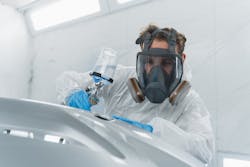Eliminate the bottleneck
In today’s body shops, we commonly hear that the paint booth is the biggest impediment to workflow. It’s true that the paint booth can be a major bottleneck, as nearly every job must funnel through it eventually. But when used properly, the booth can become a highly efficient resource that is designed to drive production and profit. Better efficiency can be gained by simply tracking refinish hours per cycle, building a booth schedule, and helping to minimize downtime.
It can be difficult for some painters to adopt new habits, especially if they come from an “old-school” mindset that values painting one job at a time. However, by thinking a little differently and knowing what to look for, painters can improve efficiency. And by hitting maximum efficiency, painters can feel as though their days have become a lot less stressful.
What is the average paint booth efficiency?
But what does paint booth efficiency look like? In North America, many shops can average four booth cycles per day. Whether you’re painting two bumpers or the entire side of a car, booth cycle time is fairly consistent. Most of the cycle is spent waiting for things to dry and bake, rather than time spent actually spraying. Thus, the only ways to produce more paint labor hours per day is to either shorten dry times enough to allow for an additional booth cycle — which is very hard to do and usually means investing in expensive drying equipment — or increase refinish hours per booth cycle, which is much easier to do.
I’ve worked with several paint companies that have tracked painter data and completed multiple time studies with their customers. When the data was analyzed, we learned that the most efficient painters average around 12 refinish hours per booth cycle. These painters rarely ran a booth cycle that only had parts from a single job. Instead, they painted all parts of the vehicle when possible and used parts stands to group smaller jobs into more efficient cycles.
As an example, let’s say we have two vehicles that are ready to paint. The first job is a vehicle that needs a new fender with a blend into the door, totaling four to six hours of refinish time. The second job is a vehicle that needs a new front door shell and blending the fender and rear door, which totals six to eight hours of refinish time.
The traditional painter might approach these jobs in two separate booth cycles. Painting each car in their own cycle will take all morning and generate 10 to 14 refinish hours for the first half of the day. Averaging these out, the painter would be getting five to seven hours per cycle. This technique wouldn’t be seen as inefficient, since the painter would end up with over 100 refinish hours for the week if they maintained that pace.
However, with a few adjustments, the same work could be completed much more efficiently.
The efficient painter would ask the body technicians or the preppers to remove the blend panels from both vehicles. While insurance may not pay for the unrequired operation to R&I the panels, it is well worth the hour of required unpaid labor. If the door from the first vehicle and the fender and door from the second vehicle were removed, the painter would have five panels on stands, which would easily fit in the booth. Both jobs could be completed during the same cycle and boost refinish hours per cycle to 10-14 hours. The efficient painter will have produced as many hours in one booth cycle as the traditional painter would in two cycles.
Other advantages to grouping jobs
Grouping jobs into fewer, more productive booth cycles can result in other benefits. Fewer masking materials are required since the entire vehicle wouldn’t have to be bagged. Paint waste would generally be reduced. It is common practice for painters to mix up to two to three extra ounces of sealer, basecoat and clear for each job to ensure they don’t run out of paint should they encounter an issue. However, by grouping jobs, that two to three ounces of sealer and clearcoat can be shared by both jobs in the same cycle. The amount of “extra” basecoat would remain the same, but the potential waste for the other two products can be minimized. Finally, as fewer booth cycles would be needed to complete the work, the paint booth would see less wear and tear – which can lead to more production before maintenance shutdowns, filter changes, and part replacements.
Not every job can be grouped and not all parts can be removed. While welded quarter panels and roofs are not going to be pulled off cars for painting, typically more than half of jobs could be grouped. This is why, as a best practice, I recommend that every painter or shop not only have a production schedule, but also build a separate booth schedule that includes the refinishing hours for each cycle. This allows them to see opportunities for job grouping or areas requiring more efficiency. Working more efficiently can have major payoffs.
So next time, instead of trying to stay later and push harder to get that extra booth cycle out, take a step back and look at how you could get more out of each cycle already planned for the day. Your shop’s bottom line will thank you!
About the Author

Jason Garfoot
Global Portfolio Manager, Paint Application Solutions
Jason Garfoot is the global portfolio manager of paint application solutions at 3M. He has been in the collision and refinish industry for over 20 years and has had nearly every role in a collision shop, working his way up from a detailer to lead painter. He also is an award-winning airbrush artist and has had his work published in many different magazines. In recent years, he has taken a more consultative role, helping many companies and shops develop new processes, products to increase efficiency in the collision repair industry. He teaches paint shop efficiency classes and implementation practices for painters, shop owners, and body shop organizations all over North America and Central Europe. He has education and degrees in collision repair, engineering, and biology.
